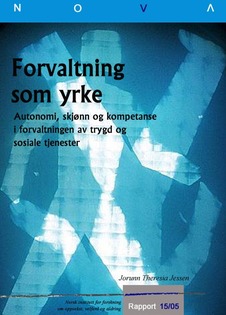| dc.description.abstract | This report presents the results from the project ö‚«Changes in welfare occupations. A comparative study of job decision latitude, competence and use of discretion within the National Insurance Service and the Social Servicesö‚». The project is financed by the Ministry of Labour and Social Affairs in the period 2002-2005. Four issues are covered by the prosject; Autonomy and job decision latitude, exercise of discretion, job satisfaction, and skilled competence. The empirical data presented in this report are based on a quantitative survey among national insurance officers and social workers officers on the local service level. The research was conducted through a random sample (25 per cent) of all the municipalities in Norway. It is based on a postal questionnaire survey distributed to employees in the two different offices (departments) located in each selected municipality in the spring of 2004.The social insurance and social assistance schemes are administered by two kinds of occupations with different professional training and education. This inequality in professional skills and required formal education is linked to the establishing of social service departments (offices). As a result of the Social Care Act (Lov om sosial omsorg) in 1964 the social service departments were given the authority to act as local administration for both financial social assistance and assistance in kind (counseling, advice and guidance). It was believed that clientele requiring social assistance also needed close supervision and follow-up from trained social workers. The Social Services therefore appointed a core staff that was professionally trained to deal with this kind of tasks. The social insurance offices administer all social insurances and earnings-related supplements, apart from the unemployment benefits which are administered by the employment service. From the start the insurance offices were staffed by civil servants, usually with little formal training; today most insurance officers have no professional education. One of the main questions of this study is how these inequalities affect their occupational roles, opportunities and self understanding as welfare workers dealing with tasks and clients. Traditionally the social insurance officers were socialized to assess relatively straightforward claims according to detailed rules and instructions. As a result of the ö‚«workfareö‚» policy the social insurance offices have been appointed new tasks and responsibilities for promoting rehabilitation involving the same kind of counseling, close interaction and follow-up as professional social workers. This also implies the ö‚«help to self-helpö‚» objectives. Changes in welfare policy and more delegation of tasks to the local administrations have lead to an enlargement of their roles from administrative officers to welfare and service workers. Because of these new tasks in guidance and assessment of benefits, the perceptions of their own occupational role as professional helpers are very similar to those of the social workers. Looking at the question of job decision latitude, we find that both occupations are to a degree controlled by job conditions. Seventy-five (75) per cent of the social workers and 90 per cent of the social insurance officers experience management by rules and directives. Because of guidelines connecting to a wide range of laws and regulations, the insurance officers are more restricted in their opportunities to make own decisions. Sixty-three (63) per cent of the social workers and 90 per cent of the social insurance officers experience management by processing times, limits and results. The insurance officers also experience more demands for efficiency. The differences are due to the fact that the National Insurance Service has implemented a new regime of management by objectives and results in order to achieve efficiency and better control over production. In spite of this new management regime, both occupations have opportunities to make autonomous decisions and independent choices as welfare workers, and they both reports that the opportunities have increased over the last years. Still the social workers in social services have more freedom to pursue the goals of their own and decide in which way the tasks shall be solved (90 per cent), than the social insurance officers (76 per cent). With regard to the question of discretion, we find a greater variation between the two occupational groups. Seventy-four (74) per cent of the social workers reports that working in social services gives them good opportunities to exercise discretion, while only 38 per cent of the social insurance officers report the same. The two occupational groups have different administrative and professional authorities and make skilled decisions in different subject areas, based on different laws. That is why the possibilities to exercise administrative discretion (constrained by rules and guidelines) and professional discretion (based on a mean-ends model) also differ. In spite of similarity in the stated official goals and a lot of similar tasks, the social work staff in the social service departments has better qualifications to exercise professional discretion and guidance than those of the social insurance officers. Still the welfare workers have different views on the importance of formal education and need for professional training. While social workers emphasize the importance of formal education, the social insurance officers in a greater degree emphasize the importance of experience in work. In their practical work personal qualities are of great importance to both groups and it seems that they are sharing the same occupational values. | en |
